#shrikrishna
Text
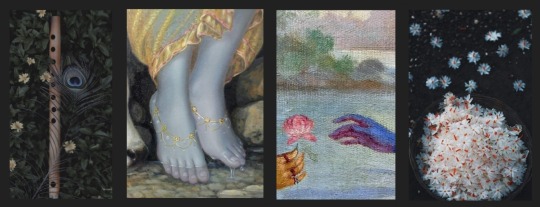
।। कृष्णात् परं किमपि तत्त्वमहं न जाने ।।
𝑨 𝑩𝑬𝑨𝑼𝑻𝑰𝑭𝑼𝑳 𝑫𝑬𝑺𝑪𝑹𝑰𝑷𝑻𝑰𝑶𝑵 𝑶𝑭 𝑺𝑯𝑹𝑬𝑬 𝑲𝑹𝑰𝑺𝑯𝑵𝑨 :
कस्तूरी तिलकं ललाट पटले वक्षः स्थले कौस्तुभं।
(𝑾𝒊𝒕𝒉 𝒕𝒉𝒆 𝒇𝒓𝒂𝒈𝒓𝒂𝒏𝒕 𝒌𝒂𝒔𝒕𝒖𝒓𝒊-𝒎𝒂𝒓𝒌 𝒐𝒏 𝒕𝒉𝒆 𝒇𝒐𝒓𝒆𝒉𝒆𝒂𝒅, 𝒕𝒉𝒆 𝒑𝒓𝒆𝒄𝒊𝒐𝒖𝒔 𝑲𝒂𝒖𝒔𝒕𝒖𝒃𝒉𝒂 𝒈𝒆𝒎 𝒐𝒏 𝒕𝒉𝒆 𝒄𝒉𝒆𝒔𝒕)
नासाग्रे वरमौक्तिकं करतले वेणुः करे कंकणं।।
(𝑻𝒉𝒆 𝒍𝒐𝒗𝒆𝒍𝒚 𝒑𝒆𝒂𝒓𝒍-𝒋𝒆𝒘𝒆𝒍 𝒂𝒕 𝒕𝒉𝒆 𝒏𝒐𝒔𝒆 𝒕𝒊𝒑, 𝒕𝒉𝒆 𝒇𝒍𝒖𝒕𝒆 𝒊𝒏 𝒕𝒉𝒆 𝒑𝒂𝒍𝒎 𝒂𝒏𝒅 𝒕𝒉𝒆 𝑲𝒂𝒏𝒌𝒂𝒏 (𝒃𝒂𝒏𝒈𝒍𝒆) 𝒆𝒏𝒄𝒊𝒓𝒄𝒍𝒊𝒏𝒈 𝒕𝒉𝒆 𝒉𝒂𝒏𝒅)
सर्वांगे हरि चन्दनं सुललितं कंठे च मुक्तावली।
(𝑻𝒉𝒆 𝒔𝒄𝒆𝒏𝒕𝒆𝒅 𝒔𝒂𝒏𝒅𝒂𝒍𝒘𝒐𝒐𝒅 𝒑𝒂𝒔𝒕𝒆 𝒂𝒍𝒍 𝒐𝒗𝒆𝒓 𝒕𝒉𝒆 𝒃𝒐𝒅𝒚, 𝒕𝒉𝒆 𝒑𝒆𝒂𝒓𝒍-𝒏𝒆𝒄𝒌𝒍𝒂𝒄𝒆 𝒂𝒅𝒐𝒓𝒏𝒊𝒏𝒈 𝒚𝒐𝒖𝒓 𝒃𝒆𝒂𝒖𝒕𝒊𝒇𝒖𝒍 𝒏𝒆𝒄𝒌)
गोपस्त्रीपरिवेष्टितो विजयते गोपाल चूडामणिः।।
(𝑺𝒖𝒓𝒓𝒐𝒖𝒏𝒅𝒆𝒅 𝒃𝒚 𝑮𝒐𝒑𝒊𝒔, 𝑴𝒂𝒚 𝒗𝒊𝒄𝒕𝒐𝒓𝒚 𝒃𝒆 𝒚𝒐𝒖𝒓𝒔, 𝑶 𝒄𝒓𝒐𝒘𝒏 𝒈𝒆𝒎 𝒐𝒇 𝑮𝒐𝒑𝒂𝒍𝒂𝒔.)
#shrikrishna#bhagwad gita#shree krishna stuti#shree krishna is life#vrindavan#hinduism#sanatandharma#hindublr#Beautiful#Spotify
130 notes
·
View notes
Text
सतयुग में आए चार बार ,
मत्स्य, कूर्म, वराह, नरसिंह अवतार;
अयोध्या नगरी चमक उठी,
जो राम जन्मे, हे दुःख हरनं ;
द्वापरयुग पावन थयो,
पड़े जो कान्हा के चरनं;
कलियुग जुवे राह तुम्हारी,
अब आ भी जाओ भगवन ||

#krishna#bhakti#shrikrishna#kanha#shreehari#radheradhe#radhakrishna#siyaram#spirtuality#spirtualjourney#growth#hindutva#hinduism
24 notes
·
View notes
Text
Song of the lord's Queens
महिष्य ऊचुः

कुररि विलपसि त्वं वीतनिद्रा न शेषे स्वपिति जगति रात्र्यामीश्वरो गुप्तबोधः।
वयमिव सखि कच्चिद्गाढनिर्भिन्नचेता नलिननयनहासोदारलीलेक्षितेन ॥ १५॥
The queens said 'Oh kurari, you are lamenting! Deprived of sleep you can't rest, while the Controller tonight is sleeping somewhere in the world at an unknown place. Can it be that your heart, just like ours, oh friend, was deeply pierced by His smiling & the munificent, playful glance of His lotus eyes?

नेत्रे निमीलयसि नक्तमदृष्टबन्धु- स्त्वं रोरवीषि करुणं बत चक्रवाकि।
दास्यं गता वयमिवाच्युतपादजुष्टां किं वा स्रजं स्पृहयसे कबरेण वोढुम्॥ १६॥
Oh cakravaki, having closed your eyes for the night, you nevertheless are crying pitifully for your unseen friend. Or do you perhaps, after having attained the servitude, just like us desire to carry in your braided hair the garland that was honored by Acyuta's feet?

भो भोः सदा निष्टनसे उदन्व- न्नलब्धनिद्रोऽधिगतप्रजागरः।
किं वा मुकुन्दापहृतात्मलाञ्छनः प्राप्तां दशां त्वं च गतो दुरत्ययाम् ॥ १७॥
Oh dear, dear ocean, you are always making such a noise, never getting any sleep. Are you suffering from sleeplessness? Or were, maybe, your personal qualities stolen by Mukunda, so that you also ended up in this hard to cure [diseased] condition?
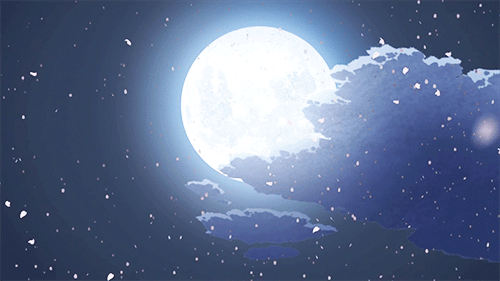
त्वं यक्ष्मणा बलवतासि गृहीत इन्दो क्षीणस्तमो न निजदीधितिभिः क्षिणोषि।
कच्चिन्मुकुन्दगदितानि यथा वयं त्वं विस्मृत्य भोः स्थगितगीरुपलक्ष्यसे नः॥ १८॥
Oh moon, are you, in the grip of the fell disease of consumption, so emaciated that you can't dispel the darkness with your rays? Or are you maybe dumbstruck, oh dearest, because you, just like us, can't remember what Mukunda all said?

किन्त्वाचरितमस्माभिर्मलयानिल तेऽप्रियम्।
गोविन्दापाङ्गनिर्भिन्ने हृदीरयसि नः स्मरम् ॥ १९॥
Oh wind from the Malaya mountains, what have we done that displeased you, so that our hearts are led by Cupid, hearts that are already torn apart by Govinda's sidelong glances?

मेघ श्रीमंस्त्वमसि दयितो यादवेन्द्रस्य नूनं श्रीवत्साङ्कं वयमिव भवान् ध्यायति प्रेमबद्धः।
अत्युत्कण्ठः शबलहृदयोऽस्मद्विधो बाष्पधाराः स्मृत्वा स्मृत्वा विसृजसि मुहुर्दुःखदस्तत्प्रसङ्गः॥ २०॥
Oh honorable cloud, you surely are a friend most dear to the Chief of the Yadavas with the Srivatsa on His chest. We are, in our meditation on pure love, just as bound to Him as your good self is. Your most eager heart is just as distraught as ours. We, just like you, remember Him over & over. And that results in torrents of rain with you, just as it time & again makes us shed streams of tears. It can be so hurtful to associate with Him!

प्रियरावपदानि भाषसे मृतसञ्जीविकयानया गिरा।
करवाणि किमद्य ते प्रियं वद मे वल्गितकण्ठ कोकिल॥ २१॥
Oh sweet-throated cuckoo, please tell me what I should do to please you, who vibrate His so very dear sounds, in this voice that is capable of reviving the dead.

न चलसि न वदस्युदारबुद्धे क्षितिधर चिन्तयसे महान्तमर्थम्।
अपि बत वसुदेवनन्दनाङ्घ्रिं वयमिव कामयसे स्तनैर्विधर्तुम् ॥ २२॥
Oh mountain with your broad-minded intelligence, you don't move or speak. Are you preoccupied with great matters, or do you maybe, just like us, desire to hold on your breasts the feet of the darling son of Vasudeva?

शुष्यद्ध्रदाः कर्शिता बत सिन्धुपत्न्यः सम्प्रत्यपास्तकमलश्रिय इष्टभर्तुः।
यद्वद्वयं मधुपतेः प्रणयावलोक- मप्राप्य मुष्टहृदयाः पुरुकर्शिताः स्म॥ २३॥
Oh [rivers] wives of the ocean, your lakes have alas lost their wealth of lotuses that shriveled away now that they dried up, just like us, who became very thin because of not obtaining the loving glance of our beloved husband, the Lord of Madhu, who so often stole our hearts.

हंस स्वागतमास्यतां पिब पयो ब्रूह्यङ्ग शौर��ः कथां दूतं त्वां नु विदाम कच्चिदजितः स्वस्त्यास्त उक्तं पुरा।
किं वा नश्चलसौहृदः स्मरति तं कस्माद्भजामो वयं क्षौद्रालापय कामदं श्रियमृते सैवैकनिष्ठा स्त्रियाम्॥ २४॥
Oh swan, be welcome & sit down, please drink some milk & tell us the news, oh dear one, for we know you to be a messenger of Sauri. Is the Unconquerable One all well? Does He, who is so fickle in His friendship, still remember that He talked to us a long time ago? Why should we [run after Him to] be of worship, oh servant of the campaka? Tell Him who raises the desire, to visit us without the goddess of fortune. Why should that woman have the exclusive right of devotion?
इतीदृशेन भावेन कृष्णे योगेश्वरेश्वरे। क्रियमाणेन माधव्यो लेभिरे परमां ��तिम् ॥ २५॥
श्रुतमात्रोऽपि यः स्त्रीणां प्रसह्याकर्षते मनः। उरुगायोरुगीतो वा पश्यन्तीनां कुतः पुनः॥ २६॥
Speaking and acting with such ecstatic love for Krishna, the Master of Yoga masters, the wives of Lord Madhava attained the ultimate goal. He, who in numerous songs is glorified in numerous ways, attracts with force the mind of any woman who but heard about Him. And how much more attractive would He then be to those who directly see Him?
- Ch 90, Canto 10, Srimad Bhagwatam
Like if you like
Follow me on IG
Chant Rakhumai Rakhumai <3
#desi academia#desi aesthetic#desi tumblr#shrikrishna#krishna#rukminikrishna#rukmini#desi culture#poetry#writers and poets#dead poets society#apricitycanvas#ashtabharya#ashtamahishi#hindu mythology#hinduism
78 notes
·
View notes
Photo

💙💙💙💛🔷🔷🔷💛💙💙💙AMAZING EXTRAORDINARY LORD SHRI KRISHNA from @artist_aaditya • Krishna-- the defender of vrindavan,, part 1 ⚜️⚜️⚜️⚜️⚜️ Krishna slays bakasura,, the crane demon Bakasura (Sanskrit: बकासुर) or Vakasura is the crane asura killed by the Hindu god Krishna. He was an evil companion of King Kansa and the brother of Putana and Aghasura.💫💫💫 👉. Reference taken from @antharyaami.arts Do check out his amazing page 🙌🙌🔥 . . #krishna #krishnalove #vrindavan #mightywarriors #shrikrishna #radheradhe #digitalillustration #digitalartpainting #digitalartworks #artstyle #characterillustration #myart #graphicdesign #mahabharat #bhagwatgita https://www.instagram.com/p/CoT1iTqOFnz/?igshid=NGJjMDIxMWI=
#krishna#krishnalove#vrindavan#mightywarriors#shrikrishna#radheradhe#digitalillustration#digitalartpainting#digitalartworks#artstyle#characterillustration#myart#graphicdesign#mahabharat#bhagwatgita
24 notes
·
View notes
Text
🌼 फुलेरा दूज / फुलरिया दूज - Phulera Dooj
◉ फुलेरा दूज, होली आगमन का प्रतीक मानी जाती है।
◉ फुलरिया दूज के बाद से ही होली की तैयारियां शुरू कर दीं जातीं हैं।
◉ इस त्यौहार से गुलरियाँ बनाने का कार्य शुरू किया जाता हैं।
◉ मथुरा और वृंदावन में फूलों की होली खेली जाती है।
◉ सर्दी के मौसम के बाद इसे विवाह का अंतिम शुभ दिन माना जाता है।
📲 https://www.bhaktibharat.com/festival/phulera-dooj

For Quick Access Download Bhakti Bharat APP:
📥 https://play.google.com/store/apps/details?id=com.bhakti.bharat.app
श्री कृष्ण भजन - Shri Krishna Bhajan
📲 https://www.bhaktibharat.com/bhajan/shri-krishna-ke-bhajan
#phuleradooj#holi#happyholi#holi2024#phuleradooj2024#krishna#mathura#radha#kanha#radhekrishna#haribol#hari#shrikrishna#phulera#dooj#festival#krishnalove#bhakti#murlidhar#radhakrishn#gopal#radheshyam
2 notes
·
View notes
Text
What was the age of Rama and Sita when they got married?
Child marriages did not exist in Ancient India. Vedas, Ithihasas, or Puranas do not mention any child marriage. All women in ancient times married after at least attaining 16 years of age, and most weddings were at Swayamvar.
Susruta, the ancient surgeon of India, wrote in his book ‘Susruta Samhita’ that the marriage age of a girl must be above 16 and for boys must be above 25 years. Many pseudo-scholars wrongly claim that Rama and Sita were kids when married, but Valmiki Ramayana proves them wrong.
Since Vedic era, Upanayana or initiation of education was considered as 2nd birth (Dwija). For Brahmins, it was done at age of 8, Kshatriyas at 11 and Vaishyas at 12. They were called Dwija (twice born) after that. Since both Sita and Rama were from Kshatriya families, both of them were initiated at 11. So after their 2nd birth (initiation), their new ages were 6 and 13 respectively, but their biological ages were 18 and 25 at marriage.
In Aranya Kanda of Valmiki Ramayana, Sita tells Ravana that she had stayed at Ayodhya for 12 years after marriage this is when Ravana appears before Sita in the guise of a saint, she entails the details of her family background.
She mentions that after her marriage with Rama, she stayed in Ayodhya for 12 years.
उषित्वा द्वा दश समाः इक्ष्वाकूणाम् निवेशने |
भुंजाना मानुषान् भोगान् सर्व काम समृद्धिनी || ३-४७-४
𝑑𝑣𝑎𝑎 𝑑𝑎𝑠ℎ𝑎 𝑠𝑎𝑚𝑎𝑎𝐻 means two & ten [twelve] years.
Sita says: "On residing in the residence of Ikshvaku-s in Ayodhya for twelve years, I was in sumptuosity of all cherishes while relishing all humanly prosperities. [3-47-4]”
Janaki also reveals that she was 18 at the time of exile while Rama was 25.
मम भर्ता महातेजा वयसा पंच विंशकः || ३-४७-१०
अष्टा दश हि वर्षाणि मम जन्मनि गण्यते |
"My great-resplendent husband was of twenty-five years of age at that time, and to me eighteen years are reckoned up from my birth. [3-47-10b, 11a]”
Sita also repeats the same to Hanuman in the Sundarkanda, stating that he stayed in Raghava’s house for a period of 12 years.
समा द्वादश तत्र अहम् राघवस्य निवेशने || ५-३३-१७
भुन्जाना मानुषान् भोगान् सर्व काम समृद्धिनी |
"I stayed in Rama's house there for twelve years, enjoying the worldly pleasures belonging to humankind and fulfilling all my desires."
On this basis, a simple conclusion has been drawn by popular Bengali authors like Rajsekhar Basu and Upendranth Mukherjee et al [2]. Both of them (and many others) have suggested in their footnotes that Sita was married to Rama when she was only six years of age.
Many great commentators of the Ramayana from the South have tried to analyse the age of Rama and Sita from the prism of spiritualism.
Nagoji Bhatta, whose famous commentry on Ramayana - “Tilaka” (whose views align with the Advaita school of Sankaracharya) [3] explains:
रावणेन त्विति । आत्मानं जिहीर्षुणा परिव्राजकरूपेण रावणेन पृष्टा वैदेही आत्मना स्वयमेवात्मानं शशंस ।। 3.47.1 ।।
ननु पूजामात्रं कर्तव्यं किं प्रतिवचनेनेत्याह ब्राह्मणश्चेति । एष अनुक्त इत्यार्षो ऽसन्धिः । अनुक्तो ऽनुक्तप्रतिवचनः ।। 3.47.2,3 ।।
सर्वकामसमृद्धिनी । व्रीह्यादित्वादिनिः ।। 3.47.4 ।।
राजमन्त्रिभी राज्ञो राज्यनिर्वाहकैर्मन्त्रिभिरित्यर्थः ।। 3.47.5 ।।
संभ्रियमाणे । संपाद्यमानसंभारे इत्यर्थः । भर्तारं दशरथम् ममार्या मम पूज्या श्वश्रूः । "अनार्या" इति क्वचित्पाठः ।। 3.47.6 ।।
मे श्वशुरं सुकृतेन परिगृह्य वररूपेण सुकृतेन वशीकृत्य । यद्वा धर्मेण शापयित्वेत्यर्थः । मम भर्तुः प्रव्राजनं भरतस्याभिषेचनमिति द्वौ वरावयाचत ।। 3.47.79 ।।
Rama’s age was around 25 years at the time of leaving Ayodhya.
Twenty-five corresponds to the twenty-five principles of the Sankhya system, of which the 25th is seen as 𝐂𝐡𝐚𝐢𝐭𝐚𝐧𝐲𝐚 𝐏𝐮𝐫𝐮𝐬𝐡𝐚 – which is Rama himself or as he is perceived to be.
In the Balakanda, Rama has been presented as an avatar of Vishnu. Being Chaityana Purusha, the whole world is pervaded by his life force, and nothing can transcend it.
In the case of Sita, 18 - represents the five subtle elements, five gross elements, five senses of action, and self, intellect and mind. This implies that Sita is the origin of these and represents Prakriti, the primordial nature of the Sankhya system. [4]
Siromani by Sivasahaya another popular commentary from the South have suggested that Rama was 28 years & not 25 at the time he left for the forest.
In the Balakanda (Sarga 20), King Dasaratha says to Viswamitra:
ऊनषोडशवर्षो मे रामो राजीवलोचनः |
न युद्धयोग्यतामस्य पश्यामि सह राक्षसैः || १-२०-२
"Less than sixteen years of age is my lotus-eyed Rama, and I see no warring aptitude to him with the demons. [1-20-2]”
Here, he probably meant that Rama is just shy of 16, could be anywhere between 15-16.
Now, ‘𝘝𝘢𝘺𝘢𝘴𝘢 𝘗𝘢𝘯𝘤𝘢𝘷𝘪𝘯𝘴𝘢𝘬𝘢𝘩’ – could mean someone whose age is 25+3 =28, if we go by the etymology of the word.
It coincides with Sita's narration. If Rama went with Viswamitra at the age of 15, married Sita the following year, then he should be 28 by the time he left the city.
Sita says she was ‘𝘢𝘴𝘵𝘢𝘥𝘢𝘴𝘢𝘷𝘢𝘳𝘴𝘢𝘯𝘪 𝘨𝘢𝘯𝘺𝘢𝘵𝘦’, so she must be 18 when she left Ayodhya. [5]
In the Ayodhyakanda, Kauslaya says to Rama that she had waited 17 years from his second birth after hearing that his son has been banished to the forest.
दश सप्त च वर्षाणि तव जातस्य राघव |
असितानि प्रकान्क्षन्त्या मया दुह्ख परिक्षयम् || २-२०-४५
Kausalya: "Oh, Rama! I have been waiting for seventeen years after your second birth of thread ceremony, with the hope that my troubles will disappear at one time or the other."
Here the word ‘𝘫𝘢𝘵𝘢𝘴𝘺𝘢’ is an indication of Rama’s age. In [1-20-2], King Dasaratha himself claims Rama was less than sixteen years i.e. fifteen years of age when he accompanied the sage Viswamitra and was eventually married to Sita.
According to Sita’s narration, Rama had spent 12 years of his married life before King Dasaratha decided to install him on the throne as Prince Regent. So, Rama’s age can’t be 17 at the time of exile.
‘Jatsaya’ means ‘born for a second time’. It has been interpreted as the second birth of Rama’s thread ceremony which indicates the investiture with the sacred thread. Going by rules laid down in Smritis, it must have taken place at the age of ten to eleven – “𝑒𝑘𝑎𝑑𝑎𝑠𝑒 𝑣𝑎 𝑟𝑎𝑗𝑎𝑛𝑦𝑎𝑚”. [6]
Thus, Rama must have been 27-28 at the time of leaving Ayodhya.
𝗖𝗿𝗶𝘁𝗶𝗰𝗮𝗹 𝗘𝗱𝗶𝘁𝗶𝗼𝗻 [𝐂𝐄]
The Critical Edition of The Ramayana has removed the shloka where Sita suggests that she was 18 years of age. Also, they have found inconsistency in the text regarding Sita’s stay in Ayodhya. The Baroda Edition suggests Sita had stayed for just one year in Rama's house after her marriage.
संवत्सरं चाध्युषिता राघवस्य निवेशने |
भुञ्जाना मानुषान्भोगान्सर्वकामसमृद्धिनी || ४||
Aranyakanda, sarga 45, states clearly that Sita stayed for one year only.
Also note, here Sita says – राघवस्य – in the house of Rama – instead of the Ikshashu family (इक्ष्वाकूणाम्), as given in the Vulgate text.
Critical Edition collected 42 manuscripts (MSS) for studying the Aranyakanda, of which they selected only 29 for use (partial or composite). The North Edition consisting of scripts in Bengali, Nepali, Maithili, Sarada, Newari, Devanagari – had 14 MSS. Likewise, Telegu, Grantha, Malayalam and Devanagari made the South Recension, which contributed to 15 MSS for the study of Aranya Kanda.
The manuscripts are not uniform regarding the event of Sita residing for one year in her in-laws' house. All Southern MSS, plus N1 –S1-D1-5 (1 Nepali script, 1 Sarada script, Five Devnagari script) and the Lahore Edition of the Ramayana have the shlokas - उषित्वा द्वा दश समाः (that is 12 years).
Whereas, N2 – V1 – B – D6-7 (2 Nepali, 1 Maithili, 1 Bengali, and Devaganri) have the shloka - संवत्सरं चाध्युषिता (that is one year). It also appears in Gorresio (Bengal) and Calcutta Editions.
Critical Edition has decided to it keep one year, with Aranya Kanda Editor P.C. Diwanji stating – “it very well suits the context.” [7]
Likewise, CE has removed this shloka - अष्टा दश हि वर्षाणि मम जन्मनि गण्यते | - (that is I am 18 years of age) and made it a three-line stanza, somewhat contrary to Valmiki's rhyme.
मम भर्ता महातेजा वयसा पञ्चविंशकः |
रामेति प्रथितो लोके गुणवान्सत्यवाक्षुचिः |
विशालाक्षो महाबाहुः सर्वभूतहिते रतः || १०||
CE has removed this shloka on the basis of transposition.
So, going by CE’s findings, Rama was 25 when he left Ayodhya. Sita (whose age is not mentioned in CE) stayed just one year with Rama after marriage before moving out, which means Rama was 24 at the time of his marriage.
CE also mentions that in Sundarkanda, Sita tells Hanuman – 5-33-17/18 – she spent twelve years in Raghava’s residence, a place that can satisfy all the objects of desire.
Once again, we see the same disparity. All Southern MSS, plus N1 –S1-D1-5 have suggested that she stayed 12 years, and on the 13th year, Rama was supposed to be coronated.
Whereas, N2 – V1 – B – D6-7 claims that Sita stayed for just one year and it also appears in Gorresio (Bengal) and Calcutta Editions. The Lahore Edition of the Ramayana doesn’t mention this shloka at all.
The Critical Edition follows a critical apparatus of filtering text, but on this occasion even they have failed to weed out inconsistencies.
The North East Recension (whom they have based their shlokas for this particular case) says Rama was 25 years of age at the time of coronation, while the North West Recension says he was 27-28.
The Bengal edition doesn’t mention the age of Rama.
General Editor of Baroda, Dr Bhatt claimed that the North West recension contains the oldest MSS and that it is the oldest composite edition – known as the Lahore edition.
Therefore, a natural question arises -- why in this case, despite having an old MSS and a composite edition, CE chose to go with a relatively later MSS on the basis of apparent logic which they felt suits the context?
It differs markedly from Sita’s version at Sundarkand. Why did the editor of the Sundarkand - G.C. Jhala - not go with Sita’s one year stay (her speech to Hanuman) to maintain the consistency?
Jhala writes in the Appendix of the Sundarkand that Sita’s speech to Hanuman has been kept as it is in line with CE’s methodology, but in Arayankanda, when the issue was raised, General editor, Bhatt, went with one year (despite not all evidence backing up) because he felt that was the most logical deduction of the event.
The CE notes in the Appendix – “The reference to 25 or 27 (regarding Rama’s age) seems to be an interpolation or later edition.”
The reason being, CE focuses on Kausalya’s speech to Rama as the focal point – that he was 17 years of age at the time of the coronation. And yet, they completely ignored the word ‘𝘫𝘢𝘵𝘢𝘴𝘺𝘢’.
CE has also kept Dasaratha’s speech to Viswamitra that is Rama was less than 16. So, if Rama gets married at 24, it’s improbable to think that it took eight years for him in the forest to kill Taraka, saving Ahalya and then moving to Mithila.
CE is implying that Rama was 17-18 years of age when he left for the forest (keeping in tune with Kausalya’s words) and negating Sita’s version of 25 years, although they didn’t remove the shloka, only suggesting it could be an interpolation. They didn't consider the concept of 'second birth' - or the Upanayana when it's clearly mentioned in the text.
Camille Bulcke [8] has suggested in Ram Katha (pg 359) that if Sita had stayed for 12 years in Ayodhya that portion was not properly documented, alluding that an avatar of Vishnu leisurely wasting 12 years of his life is unthinkable, and hence that portion is an interpolation.
So, we have to take a holistic approach here.
Going by the Vulgate, Sita was six years of age at the time of her marriage. However, cross-references and analysing the text on the pretext of the Vedic cult defies logic.
The Vedic and post-Vedic literature like the Mahabharata and the Grhyasutras suggest the minimum age of marriage for a girl is ideally 16, or it is better to say when a girl attains her puberty. [9]
King Janaka says to Viswamitra in front of Rama in Balakanda - 𝘷𝘢𝘳𝘥𝘩𝘢𝘮𝘢𝘢𝘯𝘢𝘢𝘮 𝘮𝘢𝘮𝘢 𝘢𝘢𝘵𝘮𝘢𝘫𝘢𝘢𝘮 – that is – my daughter has come of age. [1-66-24]
Also, Janaka recounts that the Kings of Aryavatra tried their luck lifting the bow to win Sita who was a Viryashulka.
ततः संवत्सरे पूर्णे क्षयं यातानि सर्वशः || १-६६-२२
साधनानि मुनिश्रेष्ठ ततोऽहं भृशदुःखितः |
“Then elapsed is a year and in anyway the possessions for livelihood went into a decline, oh, eminent sage, thereby I am highly anguished [1-66-22b, 23a]”
Does that mean, the Kings were fighting to marry a five-year-old girl at that time?
Also, it is interesting to note what Sita says to Rishi-wife Anasuya.
पति सम्योग सुलभम् वयो दृष्ट्वा तु मे पिता |
चिन्ताम् अभ्यगमद् दीनो वित्त नाशाद् इव अधनः || २-११८-३४
Sita says that her father was anxious as she has reached the age of “𝘱𝘢𝘵𝘪 𝘴𝘢𝘮𝘺𝘰𝘨𝘢 𝘴𝘶𝘭𝘢𝘣𝘩𝘢𝘮” – that means where the husband can have a holy union.
सुदीर्घस्य तु कालस्य राघवो अयम् महा द्युतिः |
विश्वामित्रेण सहितो यज्नम् द्रष्टुम् समागतः || २-११८-४४
लक्ष्मणेन सह भ्रात्रा रामः सत्य पराक्रमः |
Sita says that when all the Kings failed to lift the bow, Rama visited Mithila after “a very long time”. These are found in all MSS (no chance of interpolation) and therefore Sita’s statements here hold paramount importance.
The fact that Sita gave Rama a permanent place in her heart (1-76-14) and that the princes enjoyed pleasures in the palaces after marriage logically points to that Sita can’t be six years of age at that time. [10]
So, there can be a multitude of probabilities. Rama can be 16 or 24 at the time of marriage. However, Sita surely has crossed her puberty at the time of marriage, and can’t be six years of age.
Reference:
[1] – Valmiki Ramayana – Hanumanta Rao
[2] – Valmiki Ramayana – Rajsekhar Basu
[2] – Valmiki Ramayana – Upendranatha Mukhopadhyay
[3] Valmiki Ramayana, CE – Volume 1
[4] Valmiki Ramayana with Tilaka commentary
[5] Valmiki Ramayana – IIT
[6] Manu Smriti – Sacred Text (online)
[7] Valmiki Ramayana, CE – Volume 3
[8] Ramkatha – Camille Bulcke
[9] History of Dharmasastra – P.V. Kane
[10] The Riddle of the Ramayana – C.V. Vaidya

#ramayana#ramayan#Ramcharitmanas#valmiki ramayan#ramayan serial#ramayan sita#sita#bhagavatam#srimadbhagavatam#bhagwan shiv#mahabharata#shrimadbhagwatgeeta#bhagvadgita#padmapuran#valmiki#sriram#srimad#srikrishna#shrikrishna#rama#vedas#vedic astrology#Vedic Jyotish Online#vedic astro observations#astrology numerology vedicastrology#astrology numerology vedicastrology#vedic astro notes#vedic chart#puranas#rg veda
17 notes
·
View notes
Text
Aru Shah and The End of Time
Chapter 31 - Chapter 44
OMG ARE THEY INSIDE A DRAGON?!
I still don’t get what that Ball is, the only thing it does is glow and grows warm
So you mean to tell me that they traveled all the way to the Kingdom or Death just to activate the weapons THEY ALREADY HAD?!
I would be so mad if I was them
Okay it’s not a shocker because I had a spoilers but it’s still weird to think about how The Sleeper is Aru’s father
Well damn Aru’s grandfather is a bitch
Not the reporter making jokes about the virus, like tf
I have to say, the Sleeper is kind of an idiot
And I hope he isn’t the main villain of the series. I want someone more terrifying
This books says the the future is fixed but if you read or watch the Mahabharata you’ll see that it’s not. Destiny just knew what choice people will make no matter what. Why else would god (Krishna aka Vishnu himself) would try to change the Kuruavas mind, many times? If the Kuruavas were the prisoners of their own destiny then they wouldn’t have been considered villains.
Everyone has a choice and gods can only guide you/tell what the right path is, in the end you have to make the choice to follow it. Vishnu only reincarnates when Earth and Dharma is in trouble, and humans can’t save it.
At least that’s what I believe
The fate of people like Rama and Krishna are fixed because they were put on earth for a specific reason but normal humans future are up to our choices. Gods can’t changed that, they can only hope to lead us in the right way.
The gods do know what happens in the future but they can’t do anything because those are our choices.
I hate that Boo is Shakuni
Mini had two Harry Potter moments now
I wish Chitragupta was my uncle
Aru meet with Aiden I-
#aru shah and the end of time#aru shah#mini kapoor mercado lopez#Aiden#hanuman#boo#ramayana#mahabharata#vishnu#krishna#shrikrishna#shri ram#hinduism#hindugods#the pandava quintet#pandavas
13 notes
·
View notes
Text
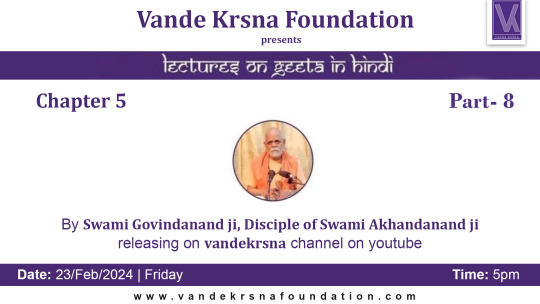
Vande Krsna Foundation presents
Lectures on Geeta in Hindi Chapter 5 Part 8 by Swami Govindanandji disciple of Swami Akhandanandji on Friday 23th February 2024 on our Vande Krsna YouTube channel at 5pm.
Stay tuned and subscribe our YouTube channel.
YouTube Channel Link:
https://www.youtube.com/channel/UCQaKIqr5ThZiEJ-WRBpP8Ug
Our Website: https://lnkd.in/g9TPb6aK
Follow On Other Social Media
👉Facebook: https://lnkd.in/dzdsSxEa
👉Instagram: https://lnkd.in/dEkeG8C6
👉Twitter: https://lnkd.in/dncDfwws
👉Tumblr: https://lnkd.in/dKNJ_BRd
👉Pinterest: https://lnkd.in/drXgCwsh
👉Reddit: https://lnkd.in/dhzyU4g7
👉Flickr: https://lnkd.in/dYDPTBcb
#geeta#bhagwatgita#shrikrishna#krishna#kanha#arjun#mahabharat#sanatandharma#dharma#hinduism#vandekrsna#akhandanandji#spiritualsolutions#problemsolving#postoftheday
2 notes
·
View notes
Text

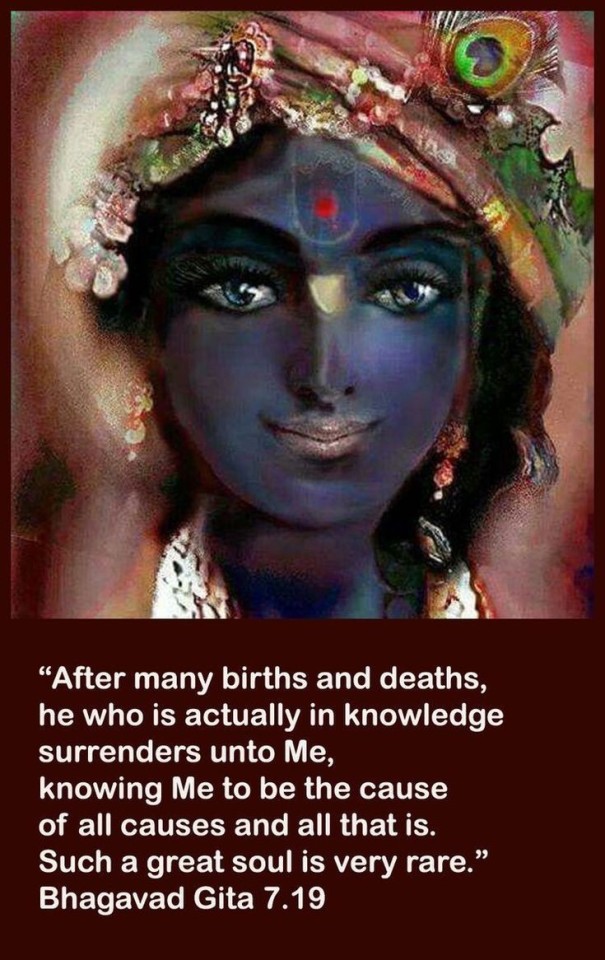
"Dont look for someone to love you; for the one who created you, waters you" -Shri krishna
2 notes
·
View notes
Photo
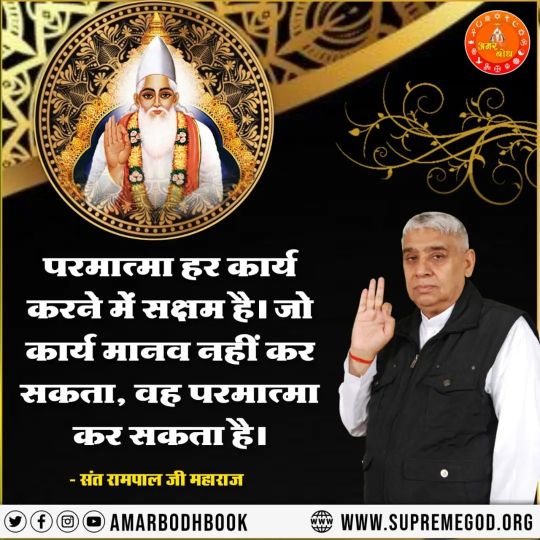
#hindiaudiobooks #yogananda #meditation #sanatandharma #hinduism #bhakti #spirituality #shrikrishna #mathura #barsana #jagannath #SantRampalJiMaharaj #GitaTeraGyanAmrit_AudioBook #SaintRampalJi #SantRampalJiMaharajApp https://www.instagram.com/p/CoUJP27SxN8/?igshid=NGJjMDIxMWI=
#hindiaudiobooks#yogananda#meditation#sanatandharma#hinduism#bhakti#spirituality#shrikrishna#mathura#barsana#jagannath#santrampaljimaharaj#gitateragyanamrit_audiobook#saintrampalji#santrampaljimaharajapp
9 notes
·
View notes
Text
youtube
~ 𝐒𝐚𝐧𝐭 𝐍𝐚𝐦𝐝𝐞𝐯 𝐉𝐢
(𝑺𝑯𝑹𝑰 𝑮𝑼𝑹𝑼 𝑮𝑹𝑨𝑵𝑻𝑯 𝑺𝑨𝑯𝑰𝑩, 𝑷. 988)
For me, the best part in bhajans written by Sant Tulsidas, Surdas, Meera Bai, Bhagat Namdev and many more... is when they refer to themselves in the last paragraph of their respective works...
It's usually a small, & simple line but it perfectly encompasses the pure love and devotion they feel for their Lord.
"...बेनु बजावै गोधनु चरै
( He plays the flute, he feeds the cows...)
नामे का स्वामी आनन्द करै ।। "
(Look how Namdev's lord rejoices.)

PC- pinterest
#gurugranthsahib#sikhism#Devaki nandan#shrikrishna#namdev#vitthal#hinduism#sanatandharma#beautiful#Youtube#vrindavan
12 notes
·
View notes
Video
youtube
9% Log He Jante Hai Govardhan Parvat Ka Ye Sach , Hme Bhi Nhi Pata Tha
Visited the india’s most ancient and sacred place Goverdhan, uttarpardesh, India
#youtube#wearedaytrippers#vlogging#krishna#harekrishna#shriradhe#shrikrishna#bhajan#krishnalove#travel#travellust#travelenthusiast#photography#photooftheday#hp
2 notes
·
View notes
Text
Mahadevi Shuddhamati
Bhīṣmaka was a ruler of the city named Kuṇḍina.
He was richly endowed with horses, elephants and chariots. He was wealthy and very powerful. Shining in the midst of a thousand women, he administered the splendid kingdom.

Mahādevī (‘great queen’) was his wife dear to him more than his own very vital breathes

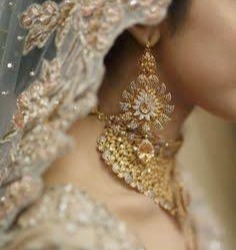
He begot of her a son named Rukmaka. The second child born was a daughter named Rukmiṇī.
At that time an unembodied etherial voice told him, “O Bhīsmaka, this girl should be given to a Four-armed One (born) on this earth.”

╰┈➤ On hearing these words, he and his beloved became delighted.
╰── ⋅ ⋅ ── ✩ ── ⋅ ⋅ ──╯

╭── ⋅ ⋅ ── ✩ ── ⋅ ⋅ ──╮
in Javanese Hinduism
Her name is Dewi Prethukirti/ Rumbini
Dewi Rukmini's mother wanted her to be married to Kresna, so she secretly informed Kresna that he should come as soon as possible to protect her daughter and they elope.
Your grandfather was the high king Kuntabhoja,And his child was none other than Kunti; Her younger siblings were your father followed by two sisters. Srutasrawa and Prethukirti. And Srutasrawa is the mother of Cedi. And it happens that he has set his mind firmly on princess Rukmini.
- Kakawin Hariwangsa
The noble Queen Prethukirti was his aunt, her relationship being the younger sibling of his father. Thus it was that he, Lord Krishna, was a first cousin to the princess.
- Kresnayana

“ According to Brahmavaivarta Purana, her name is Subhadra. She is also addressed by the name Vaidarbhi, that is, the Queen of Vidarbha.

Like if you Like
Save/reblog <3
Chant Rakhumai Rakhumai
#desi aesthetic#desi tumblr#desi culture#desi academia#hindu mythology#hinduism#javanese#shrikrishna#krishna#rukmini#apricitycanvas#ashtabharya#ashtamahishi#rukminikrishna#deepika padukone#shahid kapoor#padmavati#princess royal#queens
32 notes
·
View notes
Text
Shrimad Bhagavad Gita
Chapter 2
Verse 21
6 notes
·
View notes
Text
✨ राधाष्टमी - Radhashtami
❀ राधाष्टमी राधा रानी के अवतरण दिवस के रूप में मनाई जाती है।
❀ राधाष्टमी के दिन श्रद्धालु बरसाना की ऊँची पहाडी़ पर स्थित गहवर की परिक्रमा करते हैं।
❀ इस दिन राधा रानी और भगवान कृष्ण के विग्रह पूर्ण रूप से फूलों से सजाया जाता हैं।
❀ राधाष्टमी वह दिन है जब भक्त राधा रानी के चरणों के शुभ दर्शन प्राप्त करते हैं।
❀ राधाअष्टमी के दिन, भक्त राधा कुंड के पवित्र जल में डुबकी लेने के लिए प्रतीक्षा करते हैं।

📲 https://www.bhaktibharat.com/festival/radhashtami
🖼️ Radhashtami Whatsapp, Instagram, Facebook and Twitter Wishes and Messages
📥 https://www.bhaktibharat.com/wishes-quotes/radhashtami
🚩 राधा कृपा कटाक्ष स्त्रोत्र - Shri Radha Kriya Kataksh Stotram
📲 https://www.bhaktibharat.com/mantra/shri-radha-kriya-kataksh-stotram
🚩 आरती श्री वृषभानुसुता - राधा आरती - Radha Aarti
📲 https://www.bhaktibharat.com/aarti/radha-rani-ji-ki-aarti
🚩 श्री राधा भजन - Shri Radha Bhajan
📲 https://www.bhaktibharat.com/bhajan

#radhashtami#Brij#Shriji#Ladali#Ladliji#ShriKrishna#RadhaJayanti#Ladlilal#LadliMahal#LadaliSarkar#radha#krishna#radhakrishna#iskcon
4 notes
·
View notes
Text
Is Lord Krishna blue or green?
The base colour of Lord Krishna is bluish-dark but sometimes He appears green. Let’s see how.
Sometimes scriptures compare Krishna with a blooming blue lotus flower (sphurad-indīvara-tviṣe), with a flax flower (atasi-kusumopameya kantir), with a dark-blue newly formed monsoon cloud (ghana-śyāmaṁ), with a blue sapphire (indranīla-maṇi-mañjula-varṇaḥ), and with a Tamāla tree (tri-bhuvana-kamanaṁ tamāla-varṇaṁ).
In this way, scriptures make a lot of comparisons with various natural things just so that we, conditioned living entities, can make some sense of the transcendental complexion of Krishna.
However, Krishna’s complexion is beyond comparison. At best, His complexion can only be compared with Himself and nothing else.
indīvaraṁ vā dalitāñjanaṁ vā navāmbudo vā maghavan-maṇir vā
kṛṣṇasya dhāmnaḥ sadṛśaṁ na kiñcit tadīya-dhāmeva tadīya-dhāma
Some say Kṛṣṇa’s complexion is like a blue lotus, some say it is like eyeliner (black mascara), some say it is like a raincloud, and some say it is like a blue sapphire. Actually, nothing can compare to Kṛṣṇa’s lustre. Only Kṛṣṇa’s lustre is like Kṛṣṇa’s lustre.- Alankara Kaustubha 8.55
But still, more or less, it is accepted by all the Vedic scriptures and acharyas that the base colour of Krishna is similar to bluish-dark. However, it is also a fact that sometimes Krishna appears green, which is indicated by His name Hari.
varṇaś ca me hariśreṣṭhas tasmād dharir ahaṃ smṛtaḥ
My complexion is that of the foremost gems called Harit (green emerald). It is for these reasons that I am called by the name of Hari.- Mahabharata 12.330.3
One may ask what is this contradiction? Is He blue or green? Can you give me ONE answer and not confuse me?
Now, the confidential fact, as explained by our acharyas, is that bluish Krishna appears green when He is with golden-hued Srimati Radharani. When the colour blue and yellow mix, it appears green (please refer to the below image for reference).

Whenever Srimati Radharani and Lord Krishna stroll in the forest of Vrindavana (Vana vihara), the bright yellowish (golden) complexion of Srimati Radharani merges with the blush dark complexion of Lord Krishna, thus they appear green and turn the entire forest green.
tvaṁ hare hari-maṇi-mayīṁ vyadhāḥ kṣmām imāṁ nija-savarṇatārpaṇaiḥ |
sāpy adhāsyata vivarṇatāṁ na cet tāṁ ca kāñcana-mayīṁ vyadhāsyata ||
O Hari! You have given the forest a blue sapphire colour by offering it Your complexion. Since the creator could not change that colour, he simply mixed it with the golden colour of Rādhā’s complexion, thus making it green.- Krishna Bhavanamrta Mahakavya 8.10
A similar thing happens when Lord Krishna dances with Srimati Radharani in the Rasa Lila, He appears like an effulgent green emerald (mahā-marakato yathā- Srimad Bhagavatam 10.33.6), thus confidentially hinting at the presence of Srimati Radharani.
So, whenever devotees see the greenery of the forest, they should remember that Sri Sri Radha Madhava is strolling in the forest of Vrindavana. In this way, one should always remember the divine couple.
#lordkrishna#lord krishna#lordvishnu#lordshiva#lordram#krishna#hare krishna#harekrishna#krsna#hare krsna#srimadbhagavatam#sriram#srikrishna#srimad#shrikrishna#shrimadbhagwatgeeta#bhagavatam#bhagwan shiv#bhagvadgita#bhagavadgītā#mahabharata#bhagya#bhagavadgita#bhagavan sri ramana maharshi#mahabharat#bhagwatgeeta#bhagwan#bhagwad gita#Sagittarius#gitavali
3 notes
·
View notes